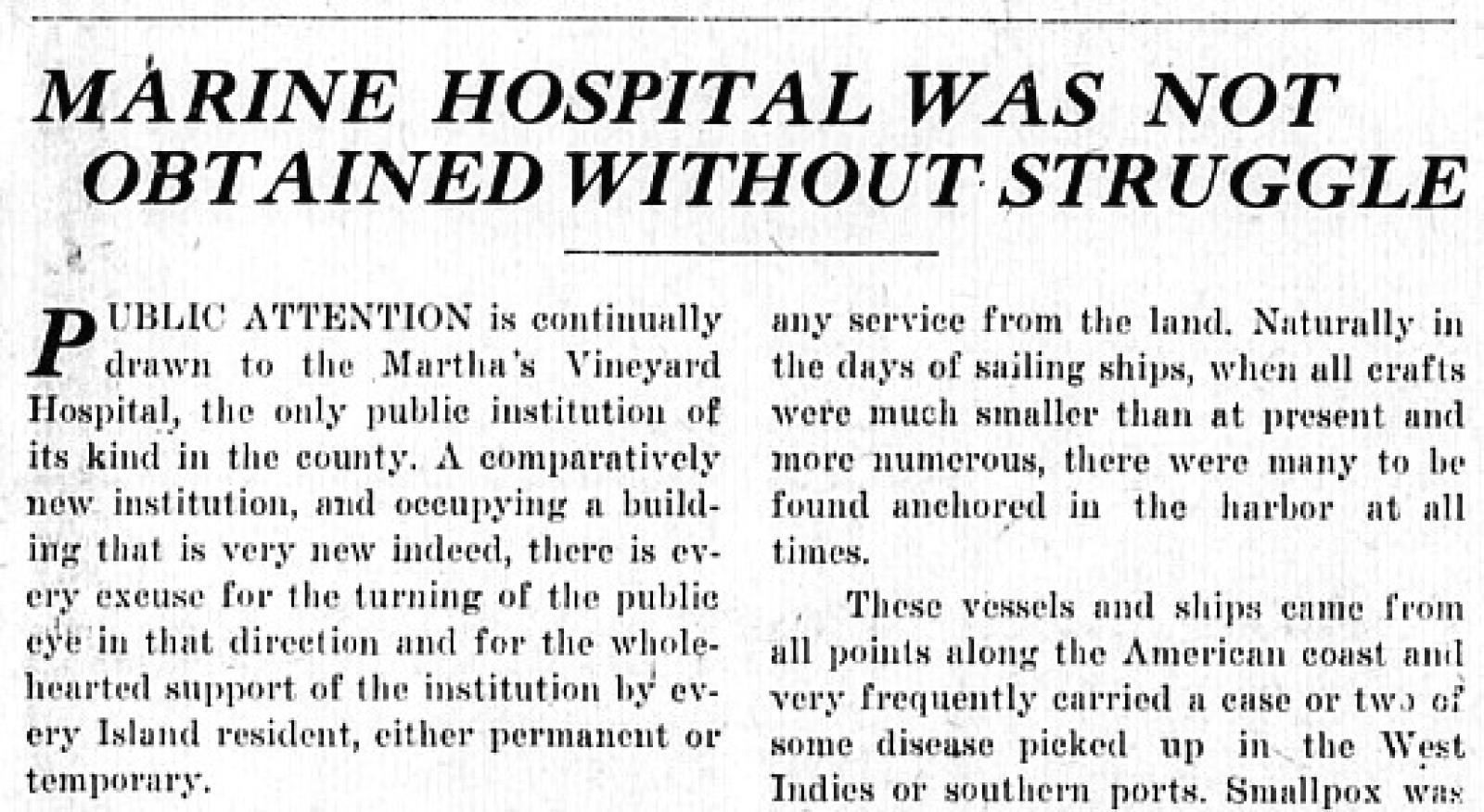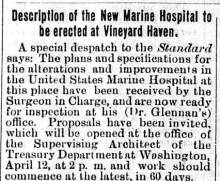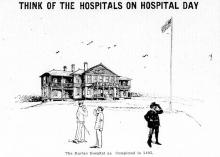Public attention is continually drawn to the Martha’s Vineyard Hospital, the only public institution of its kind in the county. A comparatively new institution, and occupying a building that is very new indeed, there is every excuse for the turning of the public eye in that direction and for the whole-hearted support of the institution be every Island resident, either permanent or temporary.
But this is not the only hospital on the Island, nor by any means the first. The first was built in 1763, and since that time there have been no less than three others constructed and used. These have all been maintained primarily for the care of seamen, although one was designed to care for any patient who might seek admission. The structure which succeeded the older three is commonly known as the United States Marine Hospital, although the Marine Hospital service was changed to the Public Health Service in 1902.
The Marine Hospital, as most people prefer to call it, is a rather imposing structure, located upon one of the most sightly hills in Vineyard Haven. Overlooking Lagoon Pond and the harbor, the building with its flag always flying in front attracts immediate attention from the visitor. Located and designed primarily for the reception and treatment of seamen, a more suitable spot could scarcely be imagined, for a boat may land at the foot of the hill on which the hospital sits, and all movements of shipping may be observed from its wide, shady verandas or the windows in the wards.
Valuable Asset to the Town
A valuable asset to the town, it was not obtained without a struggle, and the history of its establishment and the needs that brought about its building form an interesting subject, although many of the details have long since been forgotten. The Vineyard, particularly Vineyard Haven harbor, because of its location half-way between New York and Boston, has always been favored by vessels seeking shelter from storms or any service from the land. Naturally in the days of sailing ships, when all crafts were much smaller than at present and more numerous, there were many to be found anchored in the harbor at all times.
These vessels and ships came from all points along the American coast and very frequently carried a case or two of some disease picked up in the West Indies or southern ports. Smallpox was the most common and when such cases were landed, as they had to be, there was always danger that the disease might be communicated to the Island inhabitants. As a matter of fact, there were numerous epidemics of smallpox on the Vineyard in the early days, some of which were traceable to the visits of ships, or the landing on the beaches of articles thrown overboard from them.
It was in 1763 that the first hospital was established in Holmes Hole, the first hospital on the Vineyard. It was established by Dr. Samuel Gelston of Nantucket, who was empowered to carry on the work of treating smallpox patients. He was not allowed any financial aid from the town, and moreover was required to pay into the town treasury six shillings for every person inoculated against the disease. While this arrangement might not seem very fair to the hospital, it was in effect for some time and on the lapsing of the first permit it was renewed.
Other hospitals, designed for similar use, were built, one at Eastville in 1796, and one on the Edgartown-Vineyard Haven road in 1866. This, by the way, was the public institution established by Dr. William Leach. A third marine hospital was built near the site of the present on in an old lighthouse building in 1879, and the present building came in 1894.
Sailors Were “Farmed Out”
None of these buildings were built or acquired without opposition and while fights were raging in Congress or nearer home, the stream of sick and disabled sailors was coming into Vineyard Haven in undiminished numbers. Their treatment during those years when there was no hospital, was not of the best, although it was probably as good as that of the local inhabitants, afflicted with contagious disease. Sailors were “farmed out” or boarded with people who were willing to care for them. Some of these persons had had smallpox and did not fear a second attack, and there are people still living who can recall the “hospital” so-called in the down-neck section, where such patients were taken before the present marine hospital was built.
The patients were not all victims of disease, some were injured in various ways. A few scattered grave markers, one or two of them lettered, but the rest mere field stones, may be seen today on Daggett avenue, Vineyard Haven, marking the last resting place of some of those who did not recover. It is said, too, that certain of the village people who died of smallpox, were also cared for in this hospital and were buried on the sailors’ lot. Overgrown with trees today, the boundaries of the lot cannot be traced, nor the number of graves estimated.
But with the establishment of the present hospital, with its complement of about a dozen attendants, cooks, and a medical officer in charge, the system of caring for sailors changed materially for the better, and the institution has kept pace with the times in the installation of equipment and modern hospital facilities. For many years a horse-drawn ambulance was used to convey patients from the wharf to the hospital, and it was a common sight to this vehicle proceeding through the streets when a vessel appeared in the harbor with a signal set, indicating that there was a sick or injured man aboard.
The sufferings of these men while being brought into port were frightful indeed in many instances and many did not survive the ordeal, particularly during stormy weather when the sailing vessels could make but slow progress, The working of the present system, however, is a truly wonderful thing, for although the windjammer has well-nigh vanished, the sea is filled with ships and vessels, and while smallpox is a thing of the past, injuries are common and sickness afflicts the man affloat almost as often as ashore. But the method of handling the most common type of accident case is one that brings admiration. A recent case offers an example of the efficiency and expedition in reaching the hospital with an injured man.
Approximately 100 miles off Cape Cod, a man on a fishing vessel was caught in some of the machinery, breaking a leg and receiving lacerations at the same time. The vessel had no wireless, but set a signal that was seen soon after by a Coast Guard cutter on patrol in that section. The cutter came alongside, took the man aboard and made him comfortable, and headed for Vineyard Haven, meanwhile sending a radio to the Woods Hole base: “Stretcher case off fisherman, on Georges Banks. Will be at Vineyard Haven about 7 o’clock.”
The base at Woods Hole phoned the hospital at Vineyard Haven where all was put in readiness to receive the patient, and as the hour drew near a watch was kept for the lights of the cutter entering the harbor. When the boat drew alongside the wharf, the motor ambulance was waiting, its engine running, and with blankets and all necessities inside. Five minutes after landing the man was in the hospital and if it been desired could have been on the operating table.
Then there is another and even more human side to this hospital service. Some of the human wrecks thrown up by the sea can never be repaired to sail again. Too strong and ambitious for bed patients, yet unable to exist long without medical treatment and unfitted to fend for themselves, they become permanent inmates of the hospital. Here they receive such treatment as they need, a comfortable home with all comforts, and they are allowed to whittle out ship models, or other articles which they can sell to earn a few dollars from time to time.
They have no duties to perform. When the hospital was a unit in the Marine Hospital Service, the officers wore uniforms and carried a sword at inspection. The attendants also wore uniforms. At that time the discipline and regulations in force were similar to those in an army hospital and those patients who were able were required to assist in keeping the wards cleaned. There were no women nurses in the hospital then, male orderlies having charge of the wards, which sectors of the hospital were rigidly inspected after the army manner. But with the change in the service the place is conducted as civilian hospitals are, but with additional privileges added, all of which makes the place more comfortable and homelike for its inmates and reflects increasing credit on the department that administers its affairs.











Comments